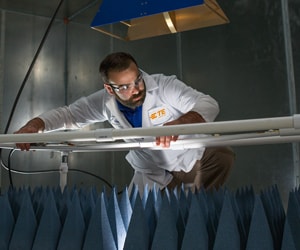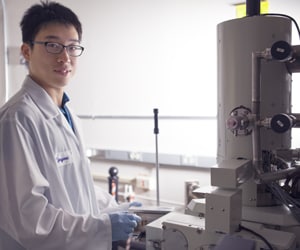
TE Perspectives
The Promise of Advanced Materials
Author: Phil Gilchrist, VP & Chief Transformation Officer, Artificial Intelligence & Sustainable Materials
Tomorrow's materials are engineering a product revolution at the very smallest of scales, well beyond what the eye can see through an optical microscope. What material can do is no longer being "discovered," as it was in the past, when, for example, the strength of a ship's oak plank was “discovered” when the plank broke.
Instead, "unnatural" materials are being invented by scientists at TE and its partners. Advances in nanotechnology, computer modeling, AI-driven materials informatics and nature-inspired designs enable engineers to manipulate a product's properties and features in ways not so long ago would have appeared magic.
We've arrived at the point of material mastery that we can program at the molecular level functions and features into seemingly inert objects to meet our needs.
TE makes highly engineered essential components and subsystems in every product imaginable, in every environment hostile to materials: from the dishwasher in your kitchen to your new EV, the human body, or the satellite-accessed data center through which you're reading this. So, materials matter deeply to TE. They are how we improve the sustainability of our world, how we copy the elegance of nature's designs, and how we will change the face of manufacturing.
Companies that recognize the exponential growth potential of advanced materials can begin developing products and manufacturing processes to help them stand out from their competition. To help understand the possibilities for advanced materials, consider these three areas of innovation.

Sustainable Alternatives to Carbon-Intensive Materials
Nearly every living thing needs oxygen, and almost every material-making process emits greenhouse gases. This reality presents a challenge around how we can reduce CO2 while still producing things the world needs. Unfortunately, recycling alone won't get us there – as those materials typically are more difficult to source, cost more and must undergo rigorous reprocessing. Additionally, we need to look at the whole lifecycle of materials, not just one phase.
Part of the answer is to look at new materials from renewable, specific biomass-derived ingredients and many (creative) options. For an exotic example, consider bioplastic monomers from shrilk. Shrilk's key ingredient is chitin, the substance that gives insects and crustaceans like shrimp their hard shells. Chitin is the second-most abundant organic material on Earth, and it can be processed into a plastic-like material called chitosan. When you combine chitosan with a natural silk protein called fibroin, it creates a laminate material that's stronger than aluminum.
Manufacturers can reduce their reliance on petro-derived materials through upcycling—adding new ingredients to lower-grade recycled materials to transform them into something more valuable. The 10 billion water bottles produced a year are a great example. Suppose we de-polymerize these water bottles (i.e., break them down into basic monomers). In that case, we can add new material components, then re-polymerize (i.e., bind all the basic monomers together again) the new recipe and create something unique. The possibilities are endless; those upcycled plastic bottles can become pillow covers and data center high-speed connectors.


Advanced Products that Use Smart Materials
We expect to see the emergence of "smart" materials that deliver the next level of functionality. Smart materials recognize external stimuli—like temperature, strain, or electrical current—and then react predictably by changing shape, color, or other properties.
Consider a material as ubiquitous as concrete. Despite its strength and versatility, concrete still develops cracks over time that require regular maintenance for the structure to maintain its integrity. Scientists have now created a new type of smart concrete that can repair itself through embedded bacteria. When the bacteria encounter water, they produce a limestone-like substance that fills the cracks.
Nature is proving to be a good source of inspiration for smart materials. After all, nature has developed its own portfolio over millions of years of evolution.
One example is the surface of a dragonfly's wing, a surface of incredibly fine spikes when viewed under a microscope. When a bacteria lands on it, the barbs on the dragonfly's wing rupture the invading organism, killing it.
Based on that model, TE is developing mechano-bactericidal material surfaces that use similar barbs to kill bacteria on contact. Think of anti-bacterial plastic wrapped around the handle of a shopping cart or airport train railing – where the commonly touched handle is rendered permanently sterile. This surface design could be a new weapon against infection in medical or food-related products.
Author Interview on Advanced Materials Development
Advanced Printed Materials and the Era of Mass Nature-Based Customization
The development of 3D printing has already transformed the manufacturing and engineering process, but new advances in 3D printing materials will allow for even more innovation. For example, new, high-grade 3D printing materials can withstand temperatures of up to 850 degrees Celsius, opening up a broader range of products that can be manufactured on demand, increasing the flexibility and viability of manufacturing in high-cost locations.
In addition, products can be made faster, with new design freedom. It’s much faster to print something from your computer screen than mill a mold out of a solid block of hardened steel.
New material engineering will accelerate the adoption of 3D printing and ultimately enable a new era of flexible production and mass customization where the material collaborates with the design. Product designers will copy the lessons of nature, incorporating curved surfaces and subtle, evolution-tested, topological shapes that optimize heat exchange. When we can design and manufacture as nature does, we will have arrived at a new stage, and 3D printing combined with new materials is the means to that end.


Putting Your Business on the Exponential Curve
Human and material histories have evolved together. But, until recently, we've "discovered" natural materials and their properties by testing them in the things we've made. Be that iron age round houses, discovering which thatch roof could withstand a rainy European winter, or the Roman's chance discovery of concrete enabling vast viaducts unmatched even today. We're now imagining use cases and then designing materials to support the use case, as our understanding of the material world and our power to manipulate it expands exponentially. And this will make all the difference. TE intends to mold the future and 3D-print it by applying great science to the toughest problems, remaking our world in a small way.
About the Author

Phil Gilchrist
Phil Gilchrist is TE's VP & Chief Transformation Officer, Artificial Intelligence & Sustainable Materials. Prior to his current role, Phil served as vice president and chief technology officer for TE’s Communications Solutions segment and as vice president and CTO of TE’s Digital Data and Devices business. He previously held a number of senior technology leadership and executive roles at Motorola after beginning his career as the co-founder of Quality Software Foundation. Phil holds a Bachelor’s degree in Computer Science from the University of Stirling in Scotland.
Insights on Innovation in Technology
More Stories on Tech Innovation



 e
e
 e
e


